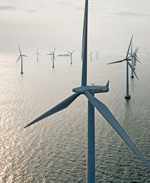
On the difficulty of governing the sea
Lack of common purpose
The sea and its ecosystem services are a common resource. Unlike privately owned properties on land, for example, they do not belong to individuals but are available to the whole community.
Many of the resources in the sea are finite, fish stocks being one example. If individual nations or companies help themselves to the sea’s resources as they see fit, sooner or later these resources will be exhausted. Today many fish populations are already classified as overfished due to excessive catches over the years. Economists use the term “commons” to talk about publicly available resources (like the fish in the sea) which are freely usable but limited in supply. Originally the concept referred to land areas such as fields or pastures used collectively by the citizens of a community.
The problem with the use of commons has always been that those interested in using this kind of resource find themselves competing with each other. If one company or country makes use of a common resource, less of it is available for the other stakeholders. From a purely economic viewpoint, it is worthwhile for a company or country to exploit these resources to the fullest possible extent in order to secure the maximum possible share and generate profits accordingly.
In past decades this approach has led to ever more serious harm to the marine environment. Unrestrained fishery is one of the uses of the commons that will tend to cause such harm. Likewise, the discharge of pollutants from industry or from municipalities into the sea is an-other example of a use of marine commons that is ulti-mately selfish. Individual companies, municipalities or countries save themselves large expenditures for the disposal of pollutants by making use of coastal waters as a free drainage tank for effluents. For the protection of commons to make sense, on the other hand, many users or states need to cooperate.
An example that clearly underscores this dilemma is fishing on the high seas, in international waters. Here the prevailing principle is that of freedom of the sea, according to which all nations can fish at will. It would be futile if one country alone refrained from fishing in order to protect overfished populations while other countries continued to fish excessively. It follows that comprehensive protection of the sea will only be possible in future if all nations will pull together with a common purposenations will pull together with a common purpose.Further information on this topic is available here:
Ocean governance – a nebulous concept
Marine protection is a matter that concerns everyone. But the question remains, how can use of the sea be regulated and governed to ensure that it is in fact sustainable? In this context researchers often speak of “governance”. Much like the term “sustainability”, no standard definition of the expression “ocean governance” currently exists. The Club of Rome, an international non-governmental organization (NGO) and expert panel founded in 1968, which deals with the negative consequences of economic growth, attempted to come up with a universal definition of the term. Accordingly, “ocean governance” was framed as the “the means by which ocean affairs are governed by governments, local communities, industries, non-governmental organizations, other stakeholders, through national and international laws, policies, customs, traditions, culture, and related institutions and processes.”
- 3.1 > A factory ship where fish are processed on board. Whether this large-scale industrial form of fishery contributes to the decline of a fish population depends on the condition of that population to begin with.
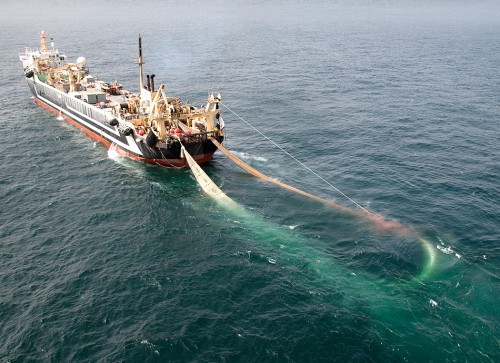
Thinking in zones
This ideal of global sustainable ocean governance has not been achieved so far, for several reasons. One reason is the subdivision of the ocean into various zones, each of which is the responsibility of different institutions. According to the Convention on the Law of the Sea (UNCLOS), which was passed in 1982 by the United Nations Conference on the Law of the Sea as a kind of global constitution of the oceans and entered into force in 1994, today the following zones of the ocean are differentiated:
- TERRITORIAL SEA: The territorial sea is the 12-nautical-mile zone. It belongs to a state’s sovereign territory, and the right of peaceful passage prevails for international shipping. The other activities in this zone are subject to the legislation of the specific states. Legislation must be in line with internationally agreed rules provided that the state has ratified UNCLOS. EXCLUSIVE ECONOMIC ZONE (EEZ): This extends from the outer edge of the territorial sea to a distance of 200 nautical miles (approximately 370 kilometres) offshore. Therefore the EEZ is also called the 200-nautical-mile zone. Included within the EEZ are the sea floor and the water column. Unlike the territorial sea, the EEZ is not part of a state’s sovereign territory. Nevertheless, in its own EEZ only the coastal state may extract resources such as petroleum and natural gas, mineral resources and, of course, fish stocks. Other nations may only use the re-sources if the coastal state consents. Resource extraction in the EEZ is subject to the coastal state’s legislation, which in turn must be in line with the international rules laid out in UNCLOS.
- CONTINENTAL SHELF: The continental shelf is the gently or steeply sloping sea floor off the coast, which is a natural geological extension of the mainland. In the case of such a geological formation the country can exploit the sea floor and its mineral resources up to a maximum of 350 nautical miles off the coast. In other words, it can extend its continental shelf rights.
- HIGH SEAS: Adjoining the 200 nautical mile zone
are the high seas, which no national state may claim for itself alone; they are available for use by all countries. Nevertheless, the use of resources in sizeable areas of the high seas is regulated. Fisheries, for instance, are regulated by one of the Regional Fisheries Management Organizations (RFMO)Regional Fisheries Management Organizations (RFMO)and its member countries, which specify maximum catch sizes for fish species. For the use and distribution of raw materials on the sea floor, in contrast, only the International Seabed Authority (ISA)Further information on this topic is available here:International Seabed Authority (ISA)is responsible.Further information on this topic is available here:
- 3.2 > The United Nations Convention on the Law of the Sea (UNCLOS) partitions the ocean into different legal zones. Within this framework, the sovereignty of a state diminishes as distance from the coast increases. Adjacent to the inner waters is the territorial sea, which is also known as the 12-nauti-cal-mile zone. Here the coastal state‘s sovereignty is already curtailed, because ships from all countries are allowed passage through these waters. In the exclusive economic zone (EEZ) which extends up to 200 nautical miles from the coast, a coastal state has the sole right to explore and harvest living and non-living resources. It is thus permitted to exploit petroleum and natural gas, mineral resources or fish stocks. In the continental shelf zone, which is a natural extension of the mainland and can extend beyond the exclusive economic zone, it may explore and harvest resources on the sea floor. Adjacent to the exclusive economic zone is the area of the high seas.
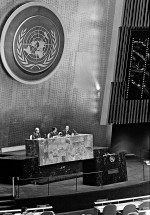 3.3 > A conference on the Convention on the Law of the Sea (UNCLOS), held in March 1982 at the United Nations in New York. UNCLOS is one of the largest legal regimes on ocean governance.
3.3 > A conference on the Convention on the Law of the Sea (UNCLOS), held in March 1982 at the United Nations in New York. UNCLOS is one of the largest legal regimes on ocean governance.  This zoning is fundamentally in conflict with any comprehensive sustainable ocean governance. Fish stocks can move across vast areas; toxic substances travel across national borders with sea currents and far beyond the bounds of an EEZ. And finally, as a consequence of climate change and particularly ocean acidification and sea-temperature rise, threats exist today which affect all marine areas equally, across all zones and borders.
Article 192 of the Convention on the Law of the Sea obliges all states parties to protect and conserve the marine environment. In addition, Article 192 ff. cites a list of obligations, setting out how states are to make use of resources in a sustainable and environmentally benign way and minimize marine pollution. Nevertheless, UNCLOS does not provide any unequivocal definition of sustainability or concrete environmental protection standards. It neither describes in detail how resources are to be used, nor can it determine, for example, catch quotas for fishery. The specifics of environmental protection are left to the individual states parties. This being the case, today it is commonplace for certain coastal states to neglect marine protection due to lack of political interest or lack of financial resources. A consistent global level of protection for the ocean has not been achieved to date.
Much the same applies to fishery in the international waters of the high seas. According to the standards set out in UNCLOS, fishery is regulated in most international ma-rine zones by one of the RFMOs. Usually it is the coastal states of a sea region that are organized in these RFMOs, along with just a few larger fishery nations. For example, the members of the RFMO responsible for the Northeast Atlantic, the North East Atlantic Fisheries Commission (NEAFC), include the European Union, Iceland, Norway and the Russian Federation. Other nations which do not belong to the RFMO responsible for the given sea area are not actually allowed to fish in that area. Nevertheless, illegal fishing could be taking place in these areas almost undetected, since such misconduct is rarely sanctioned. Irrespective of all the regulation of fishery, this means that even fish stocks in RFMO areas can be overfished.
This zoning is fundamentally in conflict with any comprehensive sustainable ocean governance. Fish stocks can move across vast areas; toxic substances travel across national borders with sea currents and far beyond the bounds of an EEZ. And finally, as a consequence of climate change and particularly ocean acidification and sea-temperature rise, threats exist today which affect all marine areas equally, across all zones and borders.
Article 192 of the Convention on the Law of the Sea obliges all states parties to protect and conserve the marine environment. In addition, Article 192 ff. cites a list of obligations, setting out how states are to make use of resources in a sustainable and environmentally benign way and minimize marine pollution. Nevertheless, UNCLOS does not provide any unequivocal definition of sustainability or concrete environmental protection standards. It neither describes in detail how resources are to be used, nor can it determine, for example, catch quotas for fishery. The specifics of environmental protection are left to the individual states parties. This being the case, today it is commonplace for certain coastal states to neglect marine protection due to lack of political interest or lack of financial resources. A consistent global level of protection for the ocean has not been achieved to date.
Much the same applies to fishery in the international waters of the high seas. According to the standards set out in UNCLOS, fishery is regulated in most international ma-rine zones by one of the RFMOs. Usually it is the coastal states of a sea region that are organized in these RFMOs, along with just a few larger fishery nations. For example, the members of the RFMO responsible for the Northeast Atlantic, the North East Atlantic Fisheries Commission (NEAFC), include the European Union, Iceland, Norway and the Russian Federation. Other nations which do not belong to the RFMO responsible for the given sea area are not actually allowed to fish in that area. Nevertheless, illegal fishing could be taking place in these areas almost undetected, since such misconduct is rarely sanctioned. Irrespective of all the regulation of fishery, this means that even fish stocks in RFMO areas can be overfished.
Too many institutions involved
A further reason why no comprehensive regime for sustainable ocean governance has yet been achieved is that different institutions are responsible for each of the vari-ous types of ocean use. At the highest political level, first of all, there are various institutions under the umbrella of the United Nations (UN) dealing with the various different use and protection aspects of the ocean; for example, the ISA headquartered in Kingston, Jamaica, and the International Maritime Organization (IMO) in London which lays down the rules for international commercial ship-ping. These are set out in international treaties, the conventions.
One example is the Ballast Water Management Convention. Ballast water is stored in special ships’ tanks. Its purpose is to keep ships stable when they are empty or lightly loaded. Depending on whether a ship in port is being loaded or unloaded, it will either pump ballast water into its tank or drain it back into the coastal waters. Along with this ballast water, in turn, marine organisms can be carried from one part of the world to another. If they become established there and suppress native species, this can change the nature of entire habitats. In order to combat the incursion of alien species, known as bio-invasion, under the terms of the convention, ballast water must be purified in future with special treatment plants on board ship.
- 3.5 > Ballast water being pumped out in a harbour. Ballast water can transport bio-invaders from one ecosystem into an-other. Some of the organisms reproduce so prolifically in foreign waters that they suppress local species. The International Maritime Organization’s International Ballast Water Management Convention therefore stipulates that ballast water must be purified in future.
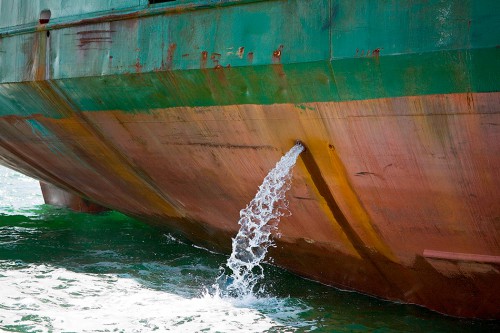
Extra Info The ground rules of international ocean governance

- The IMO also has the right, upon request from member states, to place Particularly Sensitive Sea Areas (PSSAs) under protection. These are areas where shipping is restricted or prohibited in order to protect important fishing grounds, whale breeding grounds or areas of ecological value.
Another example of a convention that was passed under the umbrella of the IMO is the International Convention for the Prevention of Pollution from Ships (MARPOL 73/78). In Annex V, in force since 1988, it prescribes to shipping which wastes have to be collected on board. According to MARPOL, for instance, the disposal of leftover food may only take place outside the 12-nautical-mile zone. Plastic waste, on the other hand, may not be thrown overboard at all according to Annex III.
The examples show that with UN authorities like the IMO or ISA taking such sectoral responsibility, it is perfectly possible to attain individual marine protection goals. But at times, having governance subdivided into different sectors can also be a hindrance. For example, no UN authority is currently able to place sea areas under complete protection – i.e. to impose protection which covers the sea floor, water column and fish stocks alike, which regulates shipping, and which prohibits other uses such as drilling for natural gas and petroleum. Moreover, on a global level there are additional UN authorities whose tasks only partly encompass marine aspects. The United Nations Food and Agricultural Organization (FAO), for instance, records data on the condition of fish stocks worldwide. Over the years it has published numerous guidelines for responsible fisheries and sustain-able fishing, but these are merely recommendations and in no way legally binding. Member states are left to decide for themselves whether or not to abide by them.
Agreements safeguard particular interests
On the regional level, too, the sectoral view of the ocean is predominant. Thus there are almost 600 agreements in existence today which have been passed by multiple states and which regulate the use or protection of the ocean in a delimited region. Examples are the “Agreement between the Government of the Russian Federation and the Republic Poland Government about cooperation in pollution abatement of the Baltic Sea, including the Kaliningrad (Vislinsky) Gulf, by oil and other harmful substances” or the “Agreement on Fisheries between the Government of Australia and the Government of Japan concerning Japanese Tuna Long Line Fishing”. The large number of agreements does not necessarily constitute evidence of any comprehensive regional marine protection or sustain-able ocean governance regime. It much rather underlines that many states pursue particular interests, which have been safeguarded over the course of time by means of agreements tailored to that purpose.
Charlie Gibbs Marine Protection Area
The Charlie Gibbs Marine Protection Area is located on what is known as the Mid-Atlantic Ridge. It is a location where continental plates are drift-ing apart from each other so that magma from the Earth’s core repeatedly flows into the sea. As a result, mountainous structures on the sea floor grow up over time and form a ridge. Individual sections of this ridge are referred to as fracture zones. Fracture zones are normally named after the research ships that studied them. In the case of the Charlie Gibbs Marine Protection Area, it was the Josiah Willard Gibbs which spent an extended stay in the area in 1968. The affix “Charlie” comes from the nearby weather station of the same name.How states cooperate on regional marine protection
Regional Seas Programmes (RSP) are another mechanism of particular significance for regional ocean governance. These are programmes in which the coastal states of par-ticular sea regions have joined forces to improve marine protection in their region. The nature of the cooperation and the protection objectives are usually set down in regional agreements. These programmes were initiated in the 1970s by the United Nations Environment Programme (UNEP). Today there are 13 Regional Seas Programmes in which 143 countries participate. Their focus is on the following 18 sea regions: Antarctica, the Arabian-Persian region, the Arctic, the Caribbean, the Caspian Sea, the Mediterranean, the Northeast Atlantic, the Northeast Pacific, the Northwest Pacific, East Africa, East Asia, the Baltic Sea, the Pacific, the Red Sea and the Gulf of Aden, the Black Sea, South Asia, the Southeast Pacific and West Africa.
In the view of experts worldwide, however, there have been only a few positive examples of good ocean governance to date within the framework of the Regional Seas Programmes. These include the Helsinki Commission (HELCOM) which is responsible for the protection of the Baltic Sea, and the Oslo-Paris Convention (OSPAR) which covers the North Sea and the Northeast Atlantic. Membership of OSPAR consists of several western and northern European countries, including the European Union, which have reached agreement to coordinate their marine protection efforts in the region of Biscay, the North Sea and the Northeast Atlantic through the OSPAR office in London.
- Under the auspices of OSPAR, progress has been made in areas such as designating areas of the high seas as marine protected areas (MPAs) even though these are located outside the exclusive economic zones of the OSPAR contracting parties. One example is the Charlie Gibbs MPA, a highly species-rich deep-sea habitat located in the Atlantic between Iceland and the Azores. Experts had feared that this habitat could be destroyed by sea-floor trawl fishing with drag nets. OSPAR and NEAFC, the regional fisheries management organization responsible for the sea region, came to an agreement to comply with the FAO guidelines on sea-floor fishing. Among other provisions, these require the complete cessation of sea-floor fishing in areas of ecological significance such as species-rich seamounts or communities of cold-water corals or sponges. In this way the Charlie Gibbs MPA was protected from future sea-floor fishing in accordance with the FAO guidelines. But in the water column above it, fish may still be caught as before. It is problematic that member states which do not belong to the corresponding RFMO, in this case the NEAFC, cannot be obliged to respect a MPA like the Charlie Gibbs Area. This makes it quite conceivable that ships from other countries might carry on sea-floor fishing in a MPA. Thanks to aerial and space surveillance and the automatic ship recognition system (Automatic Identification System, AIS) whereby a transmitter on board reports ships’ data, e.g. name and position, fishery vessels in foreign waters can nevertheless be detected. For the Charlie Gibbs area an environmental protection organization has set itself the task of using AIS to monitor shipping activity.
Gratifyingly, on the evidence so far, the area is obviously being respected by all nations. Ships engaging in sea-floor trawling have not been detected.
- 3.9 > The Charlie Gibbs Marine Protection Area in the Atlantic is populated by many bizarre deep-sea creatures like this acorn worm (Yoda purpurata). The area is special because it is one of the few protected areas in international waters.

- But another example demonstrates that the negotiation partners do not reach consensus in every case. In the Atlantic there are other areas of ecological value apart from Charlie Gibbs, which have unilaterally been declared MPAs by OSPAR but are not accepted by all NEAFC member states; one such area is the Josephine Seamount, which is located southwest of Portugal’s EEZ. Portugal is laying claim to the continental shelf beyond its EEZ and accordingly wishes to extend its mineral extraction rights to 350 nautical miles offshore – out beyond the Josephine Seamount area. For cases like this, the NEAFC regulation makes provision to grant the affected coastal state fishery rights in its continental shelf area – although the continental shelf provision pursuant to UNCLOS has nothing whatever to do with fishery but relates exclusively to mineral resources. On that basis, Portugal may carry on fishery with long lines in this case. During internal negotiations within the NEAFC over the establishment of a MPA at the Josephine Seamount, Portugal predictably expressed its opposition. Since other member countries had abstained in the last negotiations, there is currently no majority within the NEAFC in favour of the MPA. Consequently other countries have continued to engage in sea-floor trawling in the area. The most recent sightings were of Spanish and Latvian ships.
Extra Info Marine protected areas – not enough for large-scale protection

- Charlie Gibbs thus remains one of the few examples in the world of successful marine protection within the framework of the Regional Seas Programmes. In other cases, marine protection failed due to a lack of cooperation among states or because it was not made the foremost priority. One example is the Abidjan Convention responsible for the African Atlantic coast between Mauritania and South Africa, which entered into force in 1984. Due in no small part to civil wars in Côte d’Ivoire, Liberia and Sierra Leone as well as a lack of technical equipment and money, little progress has been made towards marine protection objectives since the convention took force. For some years, however, the member countries of the Abidjan Convention have been stepping up their efforts to revitalize marine protection. A first step is to identify, and systematically to document, sensitive and protection-worthy areas of the sea. This applies particularly to a large sea area which was defined in the Abidjan Convention as a Large Marine Ecosystem (LME) and extends beyond the EEZs of several West African countries. This area, the Canary Current Large Marine Ecosystem (CCLME), is especially productive because it is where the Canary Current upwells nutrients from the deep sea to the water surface. Accordingly there are high levels of algal growth, high primary production, and large quantities of zooplankton and fish. A first step towards protection of the CCLME is to make detailed maps of the area with all its habitats. To this end, in a workshop organized by the Abidjan Convention, staff were trained in geo-information systems (GIS). Beyond this, the convention supports the member countries in which oil is drilled to produce sensitivity maps. These record how sensitively particular coastal areas react to oil pollution incidents. In the case of an oil spill, these could be used to help relief workers protect areas of particular value with oil booms.
Large Marine Ecosystems
To improve the pro-tection of transboun-dary coastal regions, the US National Oceanic and Atmospheric Administration (NOAA) developed the concept of large marine ecosystems (LMEs) in the 1990s. The Earth’s coastal sea areas were divided up into 64 LMEs. Each LME is characterized by typical flora and fauna. Many LMEs are especially productive, being supplied with plentiful nutrients by rivers or upwelling currents. These produce 95 per cent of global fish biomass. The LME concept takes account of socio-economic as well as biological aspects.East Asia – hotspot of environmental degradation or of marine protection?
Under the umbrella of the United Nations Development Programme (UNDP), too, regional marine protection initiatives involving multiple countries have been brought into being over the years. Covering the East Asian region, for example, is PEMSEA (Partnerships in Environmental Management for the Seas of East Asia). PEMSEA is classified as a non-governmental organization but is a large network in which very different stakeholder representatives and institutions cooperate: representatives of national governments or local administrations, companies, educational establishments, research institutions and sponsors. The PEMSEA area extends from Thailand across Indonesia and the Philippines to the coasts of China and Japan. Within this vast expanse there are five major sea areas which are of both ecological and economic significance: the East China Sea, the Yellow Sea, the South China Sea, the Sulu and Celebes Sea and the waters around Indonesia. According to PEMSEA data around 1.5 billion people in this region live within a 100-kilometre distance of the coast. Parts of this region have undergone impressive economic development in recent years. Others, however, are plagued by deep poverty. PEMSEA considers the main threats to the marine environment to be marine pollution with plastic waste and effluents from rivers, municipalities and industry, but also nutrients from agriculture. Added to this are the issues of overfishing, destruction of coastal wetlands by building projects, and careless fishery with resultant damage to sea-floor habitats such as coral reefs.
Especially affected are industrialized and densely populated ocean bights and straits, where access to the open sea is constrained so that water can only be exchanged slowly. These include the approximately 400-kilometre-long Bohai Bay, a coastal location surrounded by several urban centres and adjacent to Beijing; the approximately 50-kilometre wide Manila Bay off the Philippines’ principal island of Luzon; and the narrow Malacca Strait between Malaysia and the Indonesian island of Sumatra. Within the PEMSEA network there are very different approaches aiming to improve marine protection in these three regions and in other areas as well. The Bohai Bay region, which is already extremely industrialized today, is primarily threatened by pollutants and nutrients transported from the hinterland by around 40 rivers. Pollution in the region is to be reduced by constructing large purification plants. Another problem in the Bohai Bay is the loss of wetland areas in the estuary delta of the Yellow River due to the construction of tourist amenities, residential settlements, industrial areas and large aquaculture facilities.
- Likewise, the Bay of Manila is surrounded by heavily industrialized and densely settled areas. Moreover, tourism and fishery are important branches of the economy. As in the Bohai Bay, water pollution and the destruction of coastal habitats are the key problems. Within the framework of PEMSEA, a strategy for Integrated Coastal Zone Management (ICZM) for the Bay of Manila is currently being developed. ICZM is based on a concept that many countries worldwide have been pursuing for some years now. It sets out to reconcile the different interests that exist in a coastal area. The goal is to bring the use of the sea and the conservation of nature into harmony as far as possible by weighing up and offsetting environmental protection, the needs of the population and the interests of business people against one another. Such strategies are elaborated by individual states in many cases. In the case of PEMSEA, however, efforts are definitely geared towards joint ICZM; for example, by bringing partners from very different nations together in workshops.
- 3.10 > The densely settled and, in places, heavily industrialized Bay of Manila is one of the most severely polluted regions of the Philippines. Plastic detritus is the most striking sign of sea pollution in this coastal area.

- Special value is also placed on the education of the population. In the workshops, for example, training is being provided to teachers, coastguard staff and press workers in informing the population about the correct way to deal with waste, which is frequently still being thrown into the sea at present. Depending on the local circumstances, the focuses of marine protection may well vary. In the Bay of Manila, projects are currently planned on the reforestation of mangroves and the establishment of protected areas for fish and turtles. How successfully PEMSEA works in reality in the different regions will remain to be seen in years to come. A crucial aspect by any standard is whether China, as the largest and most powerful economic power in the region, is willing and able to practise marine environmental protection.
Nation states themselves determine the fate of their territorial waters
Alongside these regional forms, of course, ocean governance also takes place on a nation-state level. This generally extends to the territorial sea of a country, and to its exclusive economic zone, for according to UNCLOS every individual state is to enshrine marine protection in its na-tional constitution by means of laws. It is clear from comparisons of different coastal areas in the world that marine protection enjoys a very different status from one country to another despite national environmental laws.
In 2004, for instance, Australia established a fishery exclusion zone around the Great Barrier Reef, the coral reef along the northeast coast of Australia, in order to protect shrinking fish stocks. This “no-take zone” (NTZ) with an area of 115 000 square kilometres is one of the largest worldwide. Although it caused profits from fishery to fall, many fish stocks had recovered just two years after the ban and, according to scientific analyses, economic benefits have accrued to tourism because the region has become more interesting for divers, for example. Nevertheless, even established protected areas like that of the Great Barrier Reef can find themselves at risk. It so happens that with support from the current Australian government, preparations are being made for the building of a coal port. The silt produced by the excavations will be dumped in the vicinity of the reef. Conservationists are up in arms about this plan.
- 3.11 > A major part of Australia’s Great Barrier Reef is closed to fisheries. The aim of this is to protect its native organisms such as the Pink Anemonefish Amphiprion perideraion.
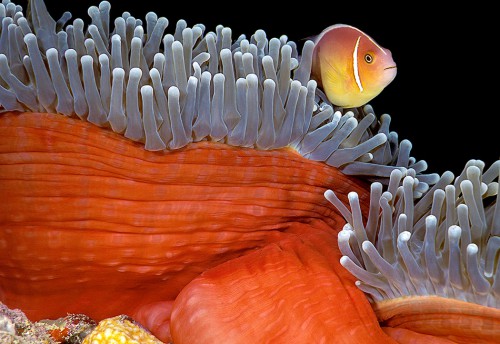
- According to a study, especially heavy pollution is found in the coastal waters off the East African coast, such as the sea area off the Tanzanian capital of Dar es Salaam. The study shows that the waters are polluted in particular with bacteria from faecal matter, with nutrients from agriculture (crop production, livestock rearing and feed production) and with metals and long-lived (persistent) pollutants from the chemicals industry. Indeed, 80 per cent of Tanzania’s industrial plants are concentrated in Dar es Salaam, including metal processing and battery, glass and paper factories, which mostly discharge their effluents unpurified. Since there are no modern purification facilities in Dar es Salaam, bacterial impurities and contaminants usually find their way directly from sewerage pipes into the sea. According to a study by Tanzanian marine researchers, the seafood there was inedible and the coastal waters downstream of the effluents were unsuit-able for bathing. Regardless of this, some beaches in the area are still used by tourists. Although there are various infiltration basins in the city which collect wastewater and allow sewage sludge to settle, these are poorly sealed, with the result that polluted water penetrates the soil and simply drains away. Moreover, the existing capacities fall short by some margin for the city which has grown drastically in recent decades. Between 1985 and 2010 alone, the population doubled. In 2012 the population grew by 6.7 per cent from the previous year.
A tool kit for good governance
Many countries are a very long way from practising good ocean governance and sustainable use of their sea areas. The separation between different sectors and domains of competence and between the global, international and national levels makes it all the more difficult to join forces and comprehensively protect the marine environment. To accomplish good ocean governance, the following criteria – which are applicable to all domains of competence and on all levels in equal measure – should be satisfied:
- SYSTEMIC APPROACH: Up until now, various marine aspects have been considered separately from each other. Economic objectives such as fishery, the construction of port and industry facilities or hotels are pursued without regard to the consequences for the environment or the needs of the coastal population. The systemic approach, on the other hand, takes into consideration that economic, social and environmental aspects are closely interwoven in one system. It also honours the fact that habitats are very complex structures in which many animal species are interconnected in food webs. Whereas past thinking about the use of ecosystem services often only considered individual organisms, today efforts are made to take a view of the ecosystem as a whole. In fisheries, for example, for a long time only the population sizes of individual fish species were of interest. In future, fishing shall increasingly be managed with prudent regard for the eco-system as a whole. An example of this is to refrain from using heavy fishing gear that damages the sea floor.
- PRECAUTIONARY APPROACH: In many cases, scientists today cannot say with certainty how severely endangered an animal species or habitat is or, for example, how dangerous a chemical substance is. According to the precautionary approach, humans should act with foresight. One example is overfishing. Fishery researchers cannot count fish. They have to make use of sample catches and mathematical models to estimate the size of a fish population. For this reason, according to the precautionary approach they recommend setting catch quotas cautiously in order to prevent such severe reduction of a fish population that it no longer produces enough offspring and succumbs to overfishing. Furthermore, researchers recommend reducing the emission or use of chemicals even if the substances are only suspected of being harmful to living organisms.
- ADAPTIVE MANAGEMENT: The biological, biochemical and physical processes in the sea are so complex that so far scientists have only gained a partial understanding of them. Equally, the changes that will occur in the wake of climate change are virtually impossible for scientists to envision today. Further research will bring new insights which must also be taken into account in future as part of ocean governance. It must therefore be shaped so as to be adaptable in the light of new scientific findings.
- TRANSPARENT INFORMATION: Scientists have conducted numerous marine research studies and pulled together thousands of facts to date. So far it has been extremely difficult to access much of this data because it has not been recorded centrally but stored in the offices or labs of individual researchers and thus widely dispersed. Often, too, data disappears in the files once projects have run their course. It is therefore a prerequisite for good ocean governance and, in particular, adaptive management that scientific findings are made rapidly accessible to the public and to policymakers. How this can work is demonstrated by the Marine Strategy Framework Directive (MSFD), the current marine protection strategy of the European Union (EU). This obliges the authorities of the EU Member States to make all data on the condition of the sea in their exclusive economic zones generally accessible on Internet portals by 2020. Thus, in future it will take just a few clicks to be able to compare data on different environmental parameters from different years – on degradation of the sea floor by fisheries, on species diversity in certain European sea areas, or on the pollutant load of the waters. Environmental policy decisions and measures can be taken on a sounder basis. Applications to carry out construction projects in the sea, such as installing offshore wind farms, can be processed more quickly; not least, because the competent authorities can more easily ascertain whether particularly sensitive or protection-worthy sea areas are affected.
- 3.12 > Wind farms in the sea can make a substantial contribution to the electricity supply. Before they are constructed, though, sites should always be assessed to ensure that sensitive marine habitats will not be destroyed.
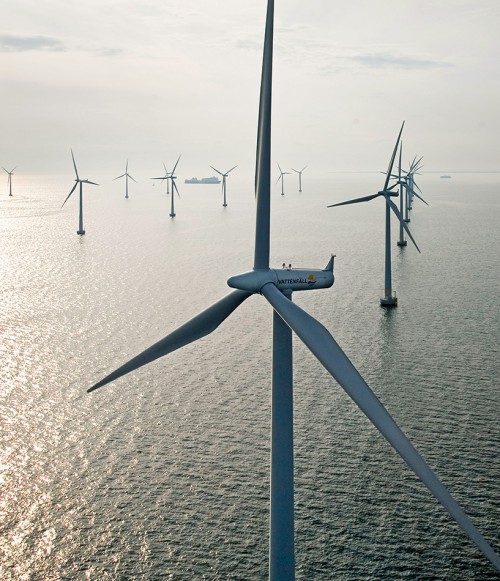
- CLEAR ALLOCATION OF USAGE RIGHTS: To prevent overuse of the collective resource of the sea, because many countries as well as corporations exploit it excessively, ocean governance should ensure that usage rights are clearly distributed. In certain circumstances, this also involves excluding potential users. One example is the allocation of fishery rights by one of the Regional Fisheries Management Organizations (RFMO). These regulate fishery in a sea area and ensure that catch quotas are distributed among member states. Other nations at greater distances from the corresponding areas do not normally receive permission to fish. The aim of this is to prevent fish stocks in international waters – which are marine commons – from being overfished.
- GLOBAL COOPERATION MECHANISMS: The sea cannot be confined by borders. Many problems cut across borders or even have a global dimension, as the phenomena of ocean warming and acidification show. Ocean governance can only work well if the interests of the many private, state, local or regional institutions and stakeholder groups can successfully be reconciled with each other. One precondition for this is that global regimes define marine protection goals more clearly than is the case today, for instance in UNCLOS. On the other hand, these regimes must be broadly framed and flexible enough to be applicable to different sea regions.
- SUBSIDIARY and PARTICIPATORY DECISION-MAKING STRUCTURES: According to the systemic approach, all interests should be given due consideration in order to gain the consent of all parties involved and to increase the acceptance of any decision. Marine protection is a global challenge. Nevertheless, the interests of the local people in the various coastal regions must be taken into account, too. Marine protection works well in situ if the people can see the logic of the protection idea. This is particularly important when it results in curtailment of the population’s usage rights. Fishers who earn a living from local fishery, for example, should have a say in what practices should be adopted to protect coral reefs – such as avoiding shallow areas in order to prevent destruction caused by boats, or refraining from dropping anchor. By the same token, they can help to determine what constitutes alternative employment of equal value in the event that fishery should be prohibited entirely for the protection of the corals.
- INCENTIVES FOR INNOVATIONS: In keeping with sus-tainable ocean governance, entrepreneurs or other stakeholder groups should be rewarded for making sustainable use of marine ecosystems and developing corresponding business models for the prudent use of the sea. In addition, development programmes should promote research, education and technology aligned with marine protection objectives. Particularly in developing countries, marine protection could be advanced by transferring knowledge and sustainable technologies.
- FAIR DISTRIBUTION MECHANISMS: Both profits from the use of marine ecosystem services and the costs of protecting the marine environment should be distributed equitably. This would prevent individual stakeholder groups from capitalizing on exploitation of the marine commons. Equally, the costs of monitoring the environmental status of the ocean should be borne collectively by the various users. This distribution of costs and benefits should take place at all levels of ocean governance, both between different countries and between the different population groups within a country. Ultimately, intergenerational distributive justice should also be taken into consideration, so that all ecosystem services will remain available to future generations without restriction.
- CONFLICT RESOLUTION MECHANISMS: Conflict resolution mechanisms are necessary in order to reconcile the diverse interests of different users. In this process, ocean governance should offer mechanisms for solving conflicts both between states and within individual countries. Nowadays there are many examples of individual stakeholder groups within countries exploiting natural capital while sizeable population groups are left empty-handed. This is happening in oil-rich Nigeria, for example. The crux of the problem is that the Nigerian government does not distribute the profits from the oil business equitably. It negotiates cooperation agreements and drilling licences with multinational oil corporations and receives annual revenues amounting to billions. Despite the existence of a distribution ratio whereby the dollar profits are supposed to be shared out between the national budget, regional governments and local administrations, very little money flows back to the drilling regions. Experts attribute this to the high prevalence of corruption at the top level of the administration. An additional factor is that ownership of any land-holdings where oil is found is automatically assigned to the national authorities under the Land Use Act of 1978. Communities or private owners are not normally compensated.
- 3.13 > According to the MARPOL agreement ships’ masters are forbidden to drain oil residues into the water in Special Areas like the North Sea. In the German Bight the coastguard uses planes and boats to hunt down illegal oil polluters.
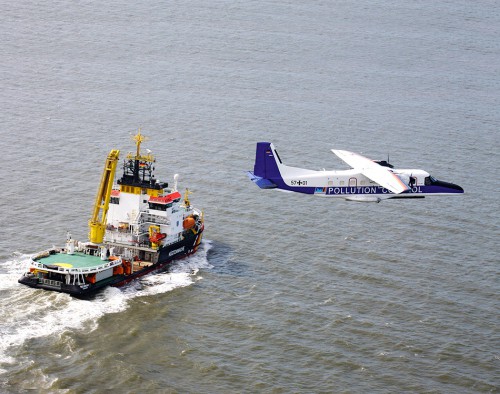
- SANCTION MECHANISMS: To ensure that all parties abide by the agreed rules, instruments must be introduced at every level of ocean governance, i.e. on the local, regional and global levels, with which misconduct can actually be sanctioned. This provides a means of enforcing compliance with usage rights, for example. Sanctions can actually be a highly effective instrument of governance, as is demonstrated by the surveillance flights that are used in certain sea areas to spot incidents of oil pollution. Under the terms of the International Convention for the Prevention of Pollution from Ships (MARPOL), since the beginning of the 1980s, seven sea regions worldwide have been defined as Special Areas (protected areas) in which the discharge of oil from ships is prohibited. In several of these Special Areas, such as the Mediterranean, the North Sea and the Baltic Sea, surveillance flights have been carried out for many years. Since patches of oil pollution can be identified very effectively by aerial photography with special cameras, ships whose crews have cleaned their tanks at sea or jettisoned oil can swiftly be caught. Because perpetrators of illegal pollution within Special Areas can be pursued by means of criminal law, the flights have a deterrent effect: the number of illegal discharges has dropped substantially.
- These general criteria for good ocean governance represent the ideal state of affairs. The first step towards comprehensive sustainable ocean governance is therefore to appraise the different levels with a view to determining how far they do or do not meet these criteria. For now, the one certainty is that there are many points where further improvement is essential.
